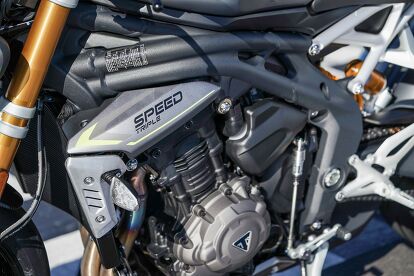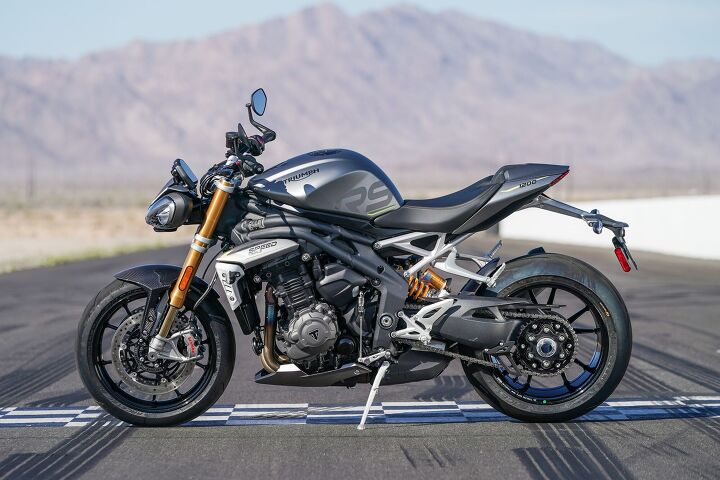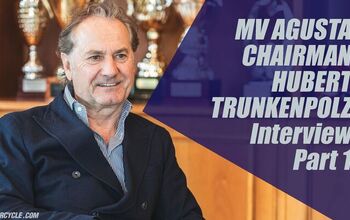2022 Triumph Speed Triple 1200 RS Review - First Ride

Bred for the streets with track-ready performance
Barreling down the back straight at triple digit speeds on the 2022 Triumph Speed Triple 1200 RS feels surprisingly comfortable. It could be the reminiscent nostalgic comfort in having owned two of this machine’s predecessors – one of which, the Speed Triple 955i, was my first street bike. Or perhaps it’s the fact the Speed Triple has always been an upright street bike first with its performance refined and enhanced over the decades (nearly three, at this point). Or maybe still, it’s the high-level componentry working in harmony with the 2022 Triumph Speed Triple 1200 RS keeping the chassis composed as I’m hard on the brakes, trailing off as I dip into the second gear left-hander.
2022 Triumph Speed Triple 1200 RS
| Engine | 19.0/20 |
| Suspension/Handling | 14.5/15 |
| Transmission/Clutch | 9.5/10 |
| Brakes | 9.5/10 |
| Instruments/Controls | 4.0/5 |
| Ergonomics/Comfort | 9.25/10 |
| Appearance/Quality | 9.5/10 |
| Desirability | 9.5/10 |
| Value | 8.0/10 |
| Overall Score | 92.75/100 |
The story of this latest Speed Triple is much the same as it has been for some time – one of constant refinement. Though the latest 1160cc Triple-powered version received a thorough overhaul while staying true to the icon that Triumph has molded and cemented in history over the years, Triumph says it’s, “The most powerful, highest torque, and fastest accelerating Speed Triple ever with a hair-raising new sound.” Despite the marketing message being essentially the same with the last Speed Triple, the new RS surpasses its elder, which is kind of what we expect with a new model, right?
Lighter, more powerful, more advanced
The big Triple has always been the allure of the Speed Triple for many a hooligan throughout the years. This latest version is now bumped up to 1160cc from the previous 1050cc mill by way of an 11mm increase in bore and a 10.6mm decrease in stroke, landing it at 90mm by 60.8mm, respectively. The Speed Triple RS has also received many of the same engine treatments that the brand’s entire line-up has, from modern classics to adventure bikes. As a result, Triumph has managed to cut 15.4 pounds from the engine alone – a pretty remarkable engineering feat that the folks in Hinckley should applaud themselves for. The changes also deliver a 12% decrease in rotational inertia within the engine.
As expected, Triumph has managed to increase the 2022 Triumph Speed Triple RS’s power output simultaneously. We had a chance to pull a few dyno runs on Rottweiler Performance’s brand new Dynojet dyno to get a real world idea of the kind of power being sent to the Striple’s 190-section rear tire. At 10,500 rpm, the 1200 RS is cranking out 156.9 horsepower with 84.9 lb-ft of torque peaking at 8,400 rpm. That means, according to our last dyno run of the Speed Triple 1050, we’ve lost a little torque right off the bottom between 2,300 – 3,500 rpm, but after 3,500, you’ve got more than three-quarters of the machine’s overall torque available to chuck you at the next apex at warp speed.
Speaking of chucking, Triumph North America decided to have our first ride of the Speed Triple RS out at Chuckwalla Raceway in the Southern California desert. Despite Triumph’s product presentation reminding us on more than one occasion that the new bike was first and foremost bred for the street, we were told we would have a half-day of track riding only for our testing. Thankfully, we were able to pry away a bike after the trackday to provide a more thorough review, complete with street impressions as well as dyno numbers and verified weight.
The tight, technical nature of Chuckwalla actually did a great job of illustrating the arm-lengthening propulsion of which the new Triple RS is capable. The new mill pulls hard from its meaty mid-range all the way to its 11,150 rpm redline. Once it’s time to get your speed in check for the next turn, the Brembo Stylemas and MCS master cylinder offer excellent power and feel while doing so. And of course, the adjustability of the MCS unit allows riders to fine tune their preferred brake feel at the lever.
With the new, and more compact, stacked 6-speed gearbox, gear changes are significantly smoother than the previous generation. The up and down quickshifter paired with the slip and assist clutch provide a light lever pull when you need to bother with it and excellent shifting through the gearbox without touching the lever – even shifting through first to second, or vice versa, is smooth if one is deliberate with their gear changes. That might be why it’s annoyingly difficult to slip the gearbox into neutral, though.
The fully-adjustable Öhlins 43mm NIX30 fork and TTX36 shock keep the machine well-suspended, though almost everyone during our sessions increased compression and rebound damping on both ends by a few clicks, which kept the bike well-balanced and composed around the tight circuit. On the street, it’s another story. The stock settings made bumps around DTLA feel harsher than I would’ve liked, so backing out a bit of damping helped. For the fork, you’ll need an allen key, but the shock’s damping is easily adjustable by hand thanks to easy-to-reach dials.
The Speed Triple 1200 RS was great around the racetrack. Its upright ergos and just high enough pegs meant that, for me, as someone who enjoys given’ er the beans but isn’t setting the world on fire with his lap times, it was a really fun track machine. Not to mention the sporty Metzeler Racetec RRs inspire confidence. What helps make the Speed Triple fun at the track carries over into my overall impression of the machine.
Triumph has been refining its electronics and engine tuning in addition to flexing its engineering strength by dropping weight throughout (22 pounds from the previous model). The refinement of the latest products to come from the folks in Hinckley is world-class. At the throttle, fueling feels impeccable, on track, you may see indications of TC working on the dash, but you can’t feel the intervention happening. Outright performance and minute adjustability are welcome when you’re absolutely pushing the limit, but when you want a well-composed, sophisticated ride, both on track and off, the Triumph Speed Triple 1200 punches at the top of its class.
Technologically
Advancement through refinement, that’s the story of the Speed Triple. The machine offers five ride modes, including a user customizable option all of which have default traction control and ABS settings (including cornering ABS in Road mode) attributed to them. Traction control can be switched between four modes or off entirely (which is also the only way to disable wheelie control) and ABS has two settings and cannot be disabled.
The braking system on the Speed triple 1200 RS is linked in the standard (Road) ABS setting, meaning that the bike will add in rear brake even if only the front lever is used. For a thorough technical description of the Road ABS setting, I’ll leave it to Triumph’s Chief Engineer, Stuart Wood:
Road ABS utilizes the modulator’s brake circuit pressure sensors, front and rear wheel speed sensors and the IMU’s 6 internal sensors (3 rate gyros and 3 accelerometers) to monitor the attitude and condition of the motorcycle. The Speed Triple 1200 RS system is more advanced than conventional 2 channel ABS systems. With a conventional 2 channel ABS system, the front and rear wheel speed sensors are used to monitor individual wheel deceleration as well as compare front to rear wheel speeds. The ABS will modulate brake pressure if wheel slip above certain thresholds is detected.
The Speed Triple 1200 RS system is more advanced than conventional 2 channel ABS systems in that in addition to the above wheel slip detections, the rider’s braking pressure demands and the motorcycle lean angle and attitude are also monitored using the IMU. This enables the system to detect panic brake applications and cornering conditions and predict the bike response earlier than a conventional system. It also allows the system to monitor the response of the bike to braking, assisting in wheel slip detection, making this more accurate (and the ABS less conservative in deciding when to activate). The result is that straight line stopping distances are reduced vs conventional systems and that the motorcycle has much smoother braking in corners.
We have added even more functionality with the Continental MIB Evo combined ABS modulator and IMU. We have the ability to apply the rear brake “by wire” as well as braking directly using the rear brake pedal. This allows us to map the amount of rear brake pressure that we apply when the front brake is used. The amount of rear brake applied varies with bike speed and front brake pressure. At very low speeds the amount of rear brake applied reduces to zero to ensure the rider has the most natural feel and control at all times. This has two main benefits. Braking distances are reduced and braking stability is improved. In addition, we now have more sophisticated anti-stop algorithms, that use rear brake by wire, allowing even higher braking deceleration before activating.
In the Track ABS setting, slip thresholds are increased, while linked braking and cornering ABS are disabled. I kept the setting in Track for most of my time at Chuckwalla, though even when the electronics denoted they were working on the dash in Sport mode, I could barely feel them doing their thing.
I appreciate Triumph giving the opportunity to test the machine at the track, but having a chance to “live” with it for a bit around town and for some longer jaunts help to showcase how great of an overall motorcycle the Speed Triple still is.
Without riding an older model back-to-back it’s hard to say with specificity, but as the dyno charts suggest, it does feel like it may have lost a bit of that really low-end grunt. Still, the 2022’s mid-range is so strong that it immediately sends you well above the government-imposed speed limits. Overall, it’s the same great streetbike it has always been. The wide handlebar puts you at just enough lean to battle the headwind, its footpegs aren’t as high as others in the class, and the seat is a wonderful place to rest your hams.
Around DTLA whilst shooting, the 1200 RS started to produce an 1160cc’s worth of heat at low speed, but that’s nothing too unexpected or bothersome. Also, with a few suspension tweaks, it handled broken pavement with ease. Since I have toured on this machine quite a bit in the past and now with the inclusion of cruise control, I wouldn’t hesitate to set out on long trips aboard this Trip’.
The TFT display on the Speed Triple RS is compact and ties in nicely to the unfaired front of the machine. I haven’t had much issue with the brand’s various dash setups in the past, but this one didn’t strike me as intuitive, though you’ll figure it out with time. What was more annoying was the amount of lag when moving through the menu, which hasn’t been a problem with any other modern Triumph’s I’ve tested lately.
“The most powerful, highest torque, and fastest accelerating Speed Triple ever with a hair-raising new sound.”
So is it? Yes, absolutely. The 2022 Triumph Speed Triple 1200 RS is a culmination of decades of advancement through refinement into what may arguably be the best large displacement sporty street bike. I’m not saying it will put down faster lap times than more razor-focused bikes in the category or higher numbers at the dyno, but what often gets overlooked when considering sporty machines is the overall package. The level of fit and finish is industry-leading, the electronics have been meticulously scrutinized to perform at the level they do, and the outright performance is nothing to shake a stick at. Being able to build a bike that’s more than down for a rip around your local racetrack whilst also being a machine you’ll enjoy living with is not an easy task, and on this, Triumph has delivered in spades with its latest Speed Triple.
2022 Triumph Speed Triple 1200 RS
+ Highs
- Stonkin Triple
- Comfy yet purposeful ergos
- Top-shelf components
– Sighs
- Not as much adjustability available to rider aids as some might expect
- The price continues to rise
- The TFT lagged more than other modern Triumphs I’ve tested
In Gear – Track

Helmet: Shoei X-Fourteen
- Suit: Alpinestars Motegi V3
- Gloves: Alpinestars Supertech R
Boots: Alpinestars Supertech R
In Gear – Street

Helmet: AGV K6 Rush
- Jacket: REV’IT! Mantis
- Jeans: Saint Unbreakable Slim
- Gloves: REV’IT! Prime
Boots: Alpinestars CRX Drystar
2022 Triumph Speed Triple 1200 Specifications | |
|---|---|
| MSRP | $18,300 |
| Engine Type | Liquid-cooled, 12 valve, DOHC, inline 3-cylinder |
| Capacity | 1160 cc |
| Bore x Stroke | 90.0 mm x 60.8 mm |
| Compression | 13.2:1 |
| Maximum Power | 156.9 hp @ 10,680 rpm (measured) |
| Maximum Torque | 84.9 lb-ft. @ 8,400 rpm (measured) |
| Fuel System | Multipoint sequential electronic fuel injection with electronic throttle control |
| Exhaust | Stainless steel 3 into 1 header system with underslung primary silencer and side mounted secondary silencer |
| Final Drive | X-ring chain |
| Clutch | Wet, multi-plate, slip & assist |
| Gearbox | 6 speed |
| Frame | Aluminum twin spar frame, bolt-on aluminum rear subframe |
| Swingarm | Aluminum, single-sided |
| Front Wheel | Cast aluminum, 17 x 3.50 in |
| Rear Wheel | Cast aluminum, 17 x 6.00 in |
| Front Tire | Metzeler Racetec RR K3 120/70 ZR17 |
| Rear Tire | Metzeler Racetec RR K3 190/55 ZR17 |
| Front Suspension | Öhlins 43 mm NIX30 upside down forks with adjustable preload, rebound and compression damping, 4.7 inches of travel. |
| Rear Suspension | Öhlins TTX36 twin tube monoshock with preload, rebound and compression damping, 4.7 inches of rear wheel travel. |
| Front Brakes | Twin 320mm floating discs. Brembo Stylema monobloc calipers, OC-ABS, radial master cylinder with separate reservoir, span & ratio adjustable. |
| Rear Brakes | Single 220mm disc. Brembo twin piston caliper, OC-ABS. Rear master cylinder with separate reservoir. |
| Instruments | Full-color 5″ TFT instruments |
| Length | 82.3 in (2090 mm) |
| Width (Handlebars) | 31.2 in (792 mm) |
| Height Without Mirrors | 42.9 in (1089 mm) |
| Seat Height | 32.7 in (830 mm) |
| Wheelbase | 56.9 in (1445 mm) |
| Rake/Trail | 23.9°/4.1 inches |
| Wet weight | 436 lb (measured) |
| Fuel Tank Capacity | 4.1 Gallons |
| Fuel Consumption | 29.4 mpg (measured) |
| CO2 Figures | 130 g/km |
| Standard | “EURO 5 CO2 emissions and fuel consumption data are measured according to regulation 168/2013/EC. Figures for fuel consumption are derived from specific test conditions and are for comparative purposes only. They may not reflect real driving results.” |
| Service interval | 10,000 miles (16,000km) / 12 months |
We are committed to finding, researching, and recommending the best products. We earn commissions from purchases you make using the retail links in our product reviews. Learn more about how this works.
Become a Motorcycle.com insider. Get the latest motorcycle news first by subscribing to our newsletter here.

Ryan’s time in the motorcycle industry has revolved around sales and marketing prior to landing a gig at Motorcycle.com. An avid motorcyclist, interested in all shapes, sizes, and colors of motorized two-wheeled vehicles, Ryan brings a young, passionate enthusiasm to the digital pages of MO.
More by Ryan Adams































































































































Comments
Join the conversation
92.75% seems very high for this bike. I definitely wouldn't call the value an 8. This bike is in a category that is stacked with lots of competition.
That was just like reading the sales brochure. Is MO on Triumph's sales team?